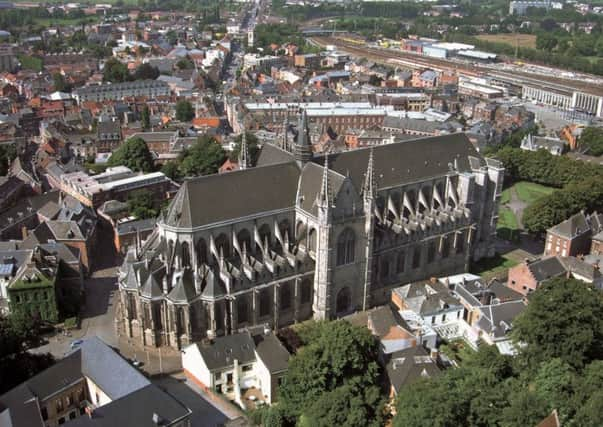Belgium: Conflict of interest


Brave Little Belgium. The part she played in the outbreak of the First World War, and her suffering as “heroic” Belgium became “martyred” Belgium, will be remembered next month when the Duke and Duchess of Cambridge and Prince Harry mark the centenary of the beginning of the First World War, when they gather in the cemetery at St Symphorien where the first and last casualties of the “war to end all wars” are buried.
In the quiet woodland cemetery lies the grave of Pte Ellison, of the Royal Irish Lancers, who was killed just an hour-and-a-half before the Armistice on November 11, 1918. Originally from Leeds, he had joined the Army as a regular soldier but left by 1912 when he married and became a miner. However, just before the outbreak of war he was recalled.
Advertisement
Hide AdAdvertisement
Hide AdHe survived some of the major battles, including the Battle of Mons in 1914 – or the Retreat from Mons, as some historians more accurately put it – but was felled by a sniper’s bullet as the epic conflict drew to a close. He barely knew his son James Cornelius, who was five days from his fifth birthday when his father died.
For an insight into the first – often overlooked – days of the war, consider a trip to the Fort de Loncin, now somewhat incongruously set in a suburban estate. It was thought to be indestructible, but its “impregnable” concrete collapsed under the weight of German shells, including those from Big Bertha which went through the ceiling of the powder room. Huge lumps of concrete weighing up to six tonnes were catapulted into the air and remain where they fell 100 years on.
Belgium’s neutrality had been guaranteed by the treaty of 1839, so when she was invaded it drew in all the countries that were to become the main protagonists of the First World War.
“Germany invaded because it was full of coal and iron and it was going to be a quick way across Belgium, cutting off all the north European ports, Dunkirk, Calais. But it failed and the British Expeditionary Force, a force with only 100,000 men against the millions of Germans and Russians, entered the fray,” said Ron Fairfax, a Hull-based historian, whose grandfather George Henry was killed in the battle of Neuve Chapelle in 1915.
Advertisement
Hide AdAdvertisement
Hide AdRon, a former lecturer and one-time battlefield tour guide, added: “People forget that it wasn’t just the Germans that fought in World War One, Belgium was up against the enormous weight of the Central Powers, and these forts which they had so much confidence in came under tremendous bombardment.”
Mons may be best known in the context of the First World War for the Angel of Mons, the popular legend that divine intervention – in the form of angels – swooped out of the sky to protect heavily-outnumbered British troops, but it is an attractive city in its own right and is set to become European Capital of Culture in 2015.
Monuments in outlying suburbs attest to the heroics of the British troops before they were forced to retreat – men like Lt Maurice James Dease, who was awarded the war’s first Victoria Cross posthumously. The only man left from his machine-gun section, he held his position despite being severely injured. After he was evacuated to die in an ambulance a young Private, Sydney Frank Godley, took over, allowing his comrades to withdraw before he was captured. By evening Mons was encircled, the British Expeditionary Force outnumbered two to one by the Germans.
Later we travel to Ploegsteert – the British soldiers called it Plugstreet – now a quiet backwater dominated by the huge Plugstreet Memorial to the Missing, listing the 11,367 names of Commonwealth soldiers with no known grave. Its tranquillity is a far cry from the “place of horrors” recalled by one soldier in 1915, “littered with the gruesome relics of earlier hand-to-hand fighting, broken fragments of rifles and bayonets, half buried bodies and swamped dug-outs.”
Advertisement
Hide AdAdvertisement
Hide AdA short ride away are the turnip fields where we line up – a little incongruously – for a photo dressed up in football shirts recalling the famous 1914 truce which took place here. Soldiers up and down the line clambered out of their dugouts to play football with the enemy. At Plugstreet they exchanged cigarettes, carols and conversation. The fraternisation frowned upon by High Command lasted a week “before they returned to business”.
Claude Verhaege, owner of the nearby L’Auberge Plug Street, runs guided tours and brings the landscape alive, pointing out where shells are buried deep, where Churchill had a safe billet, after resigning following the ill-fated Gallipoli campaign, and a field where a body was found 10 years ago. None of the trees are older than a hundred.
As one of the generals said before the Battle of Messines three years later: “Gentlemen, we may not make history tomorrow, but we will certainly change the geography.”
• Travelling from Hull to Zeebrugge summer mini cruise web fares are: Sunday to Wednesday departures from £75 per person; Thursday and Saturday departures from £79 per person; Friday departures from £115 per person. All fares include an ensuite cabin each way.
Advertisement
Hide AdAdvertisement
Hide AdThere is one sailing in each direction across the North Sea every night and the crossing time is 11 hours 30 minutes.
For more information visit www.POferries.com
The website www.visitflanders.com is a font of useful information about Flanders.